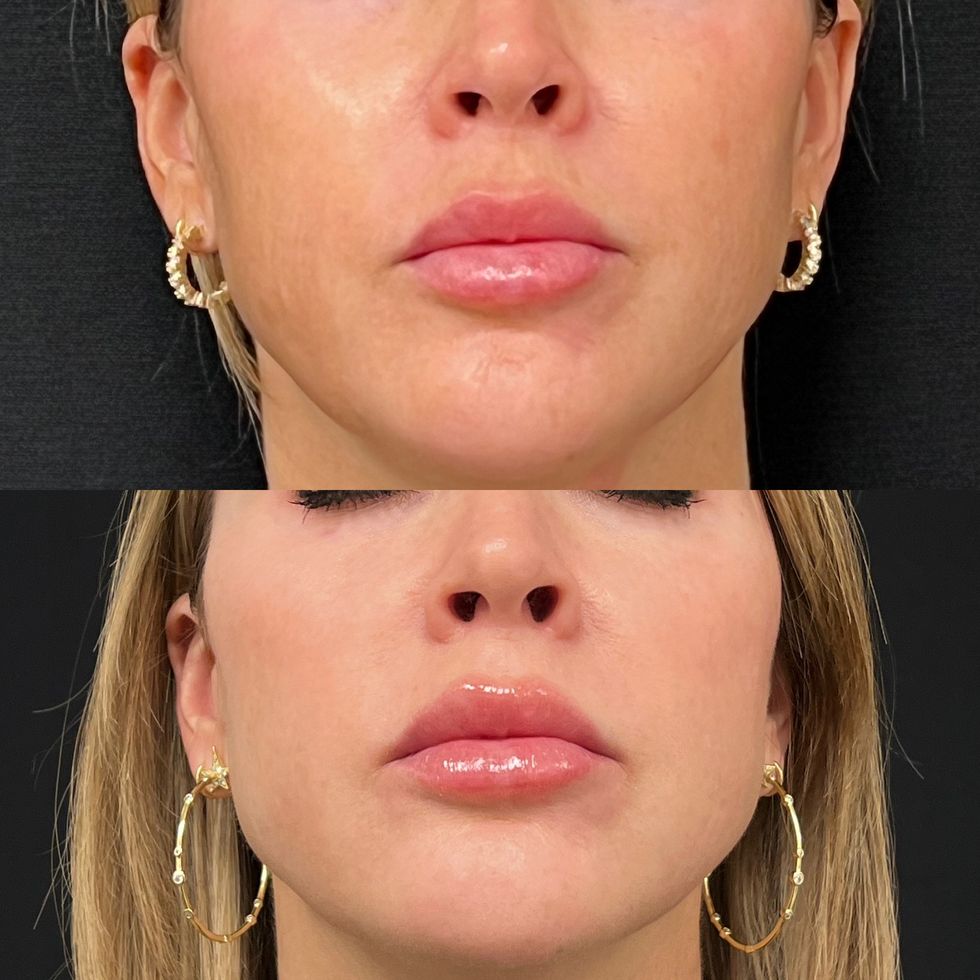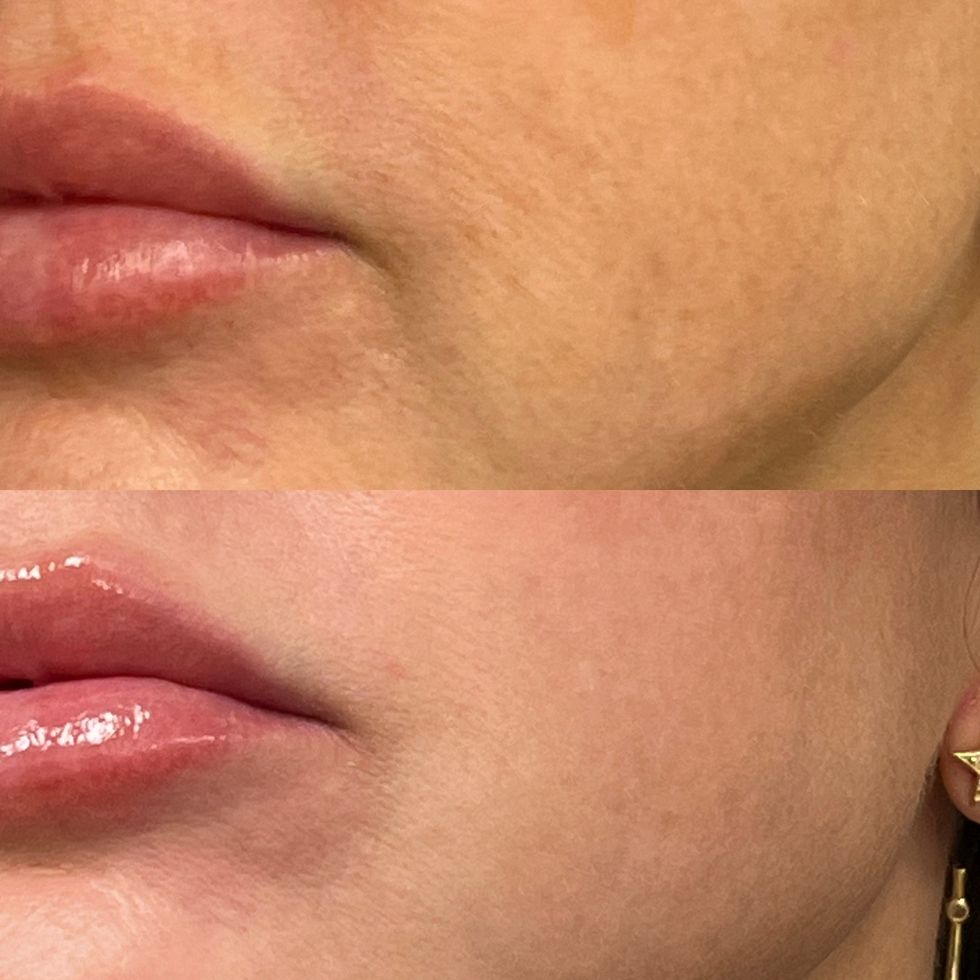SkinVive Is the New ‘Injectable Moisturizer’ Worth Paying Attention To
For a beauty editor, the allure of a buzzy new skin treatment sparkles like a shiny new toy in a child’s eager hands. However, Lindsay Silberman—an eager adult—is no beauty novice and isn’t easily swayed by fancy beauty terms or treatments with expensive price tags. The former magazine editor and founder of the cult-favorite Hotel Lobby Candle regularly publishes beauty how-tos, reviews, and the like on her blog. So when Silberman’s dermatologist suggested she try the new Skinvive treatment, she initially approached it with a hint of skepticism— especially knowing she had a major industry event to attend mere hours later. But rave reviews across the dermatologist’s office and, to be fair, a healthy dose of journalistic curiosity helped those suspicions subside. Resounding praise from a friend immediately after the treatment sealed the deal for her.
“The moment I walked in, my friend did a double-take; he almost didn’t recognize me. He said I looked ten years younger [and asked] what was I doing to my skin? I mean, I was glowing,” Silberman gushes. It had been mere hours since she’d gotten Skinvive. “I’m not kidding, at least three other people throughout the night came up to me to tell me how amazing my skin looked.”
And she’s not the only SkinVive convert. Stacie Wallis, client care coordinator at SkinSpirit Spa in Austin, Texas, tried SkinVive in hopes of improving the stubborn texture and dryness around her lower cheeks and mouth. Since receiving the injectable, she’s noticed a major difference in the area—so much so that she’s stopped wearing foundation altogether.
Now, nearly three weeks post-treatment, Silberman says her skin is still glowing and bouncy. Since rolling out at local dermatologist offices across the country in late September, Skinvive has quickly become the injectable du jour. But it’s nothing like the fillers and neuromodulators you’re used to.
Part of a new class of in-office treatments, Skinvive aims to hydrate and smooth skin without adding any of the fullness or restrictiveness generally associated with injectables. To get the lowdown and learn what separates Skinvive from neuromodulators and fillers, I spoke to Ariel Ostad, MD, triple-board certified cosmetic surgeon; Kenneth Mark, MD, board-certified dermatologist, and Dendy Engelman, MD, a board-certified dermatologist based in New York.
What is Skinvive?
Skinvive is a buzzy, first-of-its-kind hyaluronic acid microdroplet injectable meant to improve skin smoothness and hydration, per Dr. Ostad. While it has been regularly referred to as a form of facial filler since receiving FDA approval in May 2023, Dr. Mark eschews the misconception, likening the treatment to “a long-lasting, heavy-duty injectable moisturizer” instead. Dr. Engelman uses similar terminology, referring to Skinvive as “an injectable skin hydrator.”
The confusion is warranted, in a way. Essentially, Skinvive is a “skin booster,” which refers to a class of skin quality-enhancing injectables that deliver microdroplets of hyaluronic acid into the top layers of skin to increase hydration, smooth texture, and generally improve skin appearance without changing the facial structure. While they’ve been available (and quite popular) in Europe, Asia, and other parts of the world for years, Skinvive is the first skin booster approved by the FDA. In other terms, the Skinvive rollout isn’t just introducing the particular treatment to the U.S. market, but rather the entire skin booster category.
What exactly does Skinvive do?
“Skinvive helps the skin retain its natural moisture and softness, leading to an improvement in the smoothness of the skin,” explains Dr. Ostad. “It also helps improve skin quality as well as fine lines, wrinkles, and crepiness on the skin.” While the clinical trial that led to FDA approval focused on skin smoothness in particular—patients noted marked improvements in skin hydration and texture in the cheeks that lasted for six months—Dr. Mark says benefits include overall enhanced glow, radiance, and plumpness. Research suggests it also stimulates collagen production, improves elasticity, decreases dullness, and reduces the appearance of fine lines.
Before Skinvive, Dr. Ostad says he and his colleagues generally relied on laser treatments to boost hydration at a treatment level (versus topical products, which can certainly help but only to an extent). Where laser treatments often require downtime and peeling before seeing results, “now patients can be treated within a matter of minutes and see results right away,” Dr. Ostad adds
Meanwhile, Dr. Engelman seems most impressed with the wide range of potential patients. “In my practice, we’ve been using Skinvive on patients of all ages and skin tones—those looking for a skin textural quality change, those who are interested in improving cheek-skin smoothness and hydration because they have dry skin, as well as filler patients who are losing hyaluronic acid due to aging and have crepey skin.”
What’s the difference between skin boosters like Skinvive and fillers?
Most fillers and skin boosters feature the same active ingredient, hyaluronic acid. However, traditional fillers change the shape of the face, while skin boosters change the appearance of the face. These different intended uses translate directly to the formulation; hyaluronic acid fillers have a thicker consistency, which adds volume to the skin, whereas Skinvive has more of a water-like texture that boosts hydration in the skin, explains Dr. Ostad. On a more technical level, he says, Skinvive contains 12 milligrams of hyaluronic acid per milliliter, which is around half the concentration found in traditional fillers.
Another key difference is the treatment area. Fillers generally sit in the area where injected. For example, your cheeks won’t appear fuller post-lip injections. Alternatively, Skinvive’s ultra-thin consistency allows it to spread throughout the epidermis, affecting the entire skin quality rather than just a particular region. This is true across the border for skin boosters.
How does it work?
For the uninitiated, hyaluronic acid is a popular humectant used in skin care, thanks to its ability to draw and retain moisture.. Skinvive leverages those moisture-attracting and -retaining qualities to hydrate the skin and create a healthy, glowing complexion. When injected into the skin, Skinvive disperses and diffuses into an even layer to boost hydration throughout the entire face rather than in a specific area.
The treatment itself is simple. There’s barely any prep work, just removing makeup and cleansing the skin. Then, a series of injections are made in the cheeks using tiny needles, which Dr. Mark says can be done in as little as 10 minutes. (Dr. Ostad suggests a slightly more conservative 10 to 20 minutes, but the point remains the same.) Skinvive utilizes a microdroplet technique that delivers a minimum of 20 injections per cheek at a time, Dr. Mark explains. Per Dr. Engelman, it’s injected into the epidermis, at a fairly superficial depth, especially compared to other injectables, and downtime is virtually nonexistent.
It’s worth noting that Dr. Engelman does numb the area for around 15 to 20 minutes before treating, though it’s not technically necessary. “The treatment itself is not painful per se but there are quite a few pricks involved,” she explains. “I always want my patients to feel comfortable when they are in my chair.”
According to Dr. Ostad, results can be seen immediately and continue to improve over the next several weeks, with full, peak results usually appearing within a month.
What’s the difference between Skinvive and Profhilo?
Profhilo is a popular skin booster in Europe, though it hasn’t been approved for use in the U.S. Profhilo has a higher concentration of hyaluronic acid, according to Dr. Mark, and requires a second dose at the four-week mark. Those concentrations correlate with different needle sizes—at 32 gauge, Skinvive employs the smallest needle available to deliver many tiny injections into the skin, whereas Profhilo uses a larger one to administer around five injections per cheek.
How long does it last?
Results last anywhere between six months to a year, Dr. Ostad shares. Though some patients in the clinical trials requested touch-ups around the one-month mark, they were generally satisfied with the glow and increased hydration through six months.
How much does it cost?
Prices vary depending on the amount of syringes used, the area of the face injected, and the geographical location of the procedure. While Dr. Ostad and Dr. Engelman say it can cost anywhere from $750 to $1,200 per syringe, Dr. Mark says to expect somewhere within the range of $1,500 and $3,000.
What are the risks associated with Skinvive?
As with any injection, Skinvive does come with the risk of bruising and localized swelling, both of which are relatively common but mild, Dr. Mark says. There are also potential risks of redness and tenderness around injection sites, though Dr. Engelman notes it should go away after a few days. The most serious, albeit rare, risk is the potential for vascular occlusion. “With any filler, there is a risk of vascular occlusion,” Dr. Ostad explains. “Any injector needs to know the facial anatomy of arteries, veins, nerves, and muscles properly to avoid this. You need to stay superficial to avoid hitting the blood vessel.”
It’s also worth noting that the effects of Skinvive, but also skin boosters in general, provide subtle improvements in skin quality; before-and-afters aren’t going to look as dramatic as they do with other injectables, so it’s important to go into the treatment with realistic expectations. Of course, risks are amplified when administered by unqualified practitioners. Be sure you go to a board-certified dermatologist or cosmetic/plastic surgeon, and don’t be afraid to ask questions.




